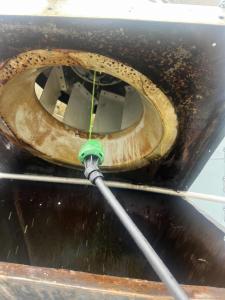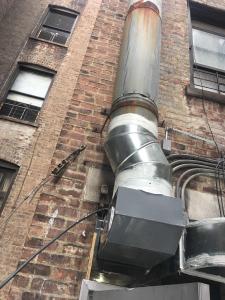
Inside the Fire Code: What NYC Restaurants Need to Know About Hood Cleaning
A kitchen fire can start in an instant when grease in the hood ignites and is drawn up through the ventilation. FDNY officials explain that if “a flame flares up on the stove and comes in contact with the exhaust hood, it can cause the build-up grease to be ignited.” Because the exhaust fan is running, that flame – and the fire – is sucked into the ducts and can spread rapidly. FDNY notes that this scenario “can act as fuel and spread the fire up the duct, potentially into the exhaust fan.” The result: a blaze in the very system meant to vent smoke, often leading to catastrophic damage. In the worst cases, the department warns, the restaurant must stay “shut down until the system is put back into service and final approval issued by the FDNY.” That can translate into weeks of closure and lost income.
Filta Kleen’s senior hood technician, has seen it firsthand. “We often pull out chunks of black, carbonized grease that have been growing for months,” they said. “One tiny kitchen flare-up can turn all that buildup into a chimney of fire. Not cleaning on schedule is like storing gasoline under your stovetop.”
His colleague, Sofia, a longtime operations manager with Filta Kleen, emphasized that cleaning isn’t just about removing buildup—it’s about understanding the full system. “In a lot of cases, we find exhaust fans running inefficiently because the blades are weighed down with hardened grease,” she said. “Even the filters can look clean from the outside but be completely clogged inside. When airflow is compromised, so is your safety.”
In recent years NYC regulators have tightened the screws on kitchen ventilation. The FDNY now requires that all grease exhaust systems be cleaned by FDNY-approved technicians at least quarterly (or more often). Only companies with a Commercial Cooking Exhaust System Servicing certificate (and workers holding the W-64/P-64 Certificate of Fitness) can legally perform the cleanings. Even restaurant staff must track grease levels on filters and schedule external cleanings. Any lapse is a violation of the Fire Code – and inspectors can write summonses or order an immediate shutdown.
The Department of Environmental Protection (DEP) is also raising the bar. In January 2025, DEP proposed a strict “Charbroil Rule” to slash cooking emissions: restaurants using large old charbroilers must retrofit their hoods or install scrubbers to cut particulate pollution by 75%. While primarily an air-quality measure, the rule implicitly forces owners to overhaul antiquated vents and ducts. Building owners are reminded that any new or modified kitchen hood requires a permit from the NYC Department of Buildings and must comply with the Mechanical Code. In short, city law now leaves little wiggle room: a clean, code-compliant hood is not just best practice, it’s mandatory.
“Our clients don’t realize that the code is very clear,” said Kim. “In NYC, you need a current FDNY sticker on the hood and logs proving quarterly cleanings. If a fire marshal finds an expired tag or a grease coating, you’re looking at fines or worse.”
Another technician from the Filta Kleen team, Marcus, who specializes in commercial kitchens in lower Manhattan, pointed to a concerning pattern. “We’re seeing more owners who assume once-a-year cleaning is enough. But in a busy kitchen running fryers, grills, and ovens every day, quarterly is the bare minimum,” Marcus said. “I’ve had to stop mid-job and call the FDNY when I found ductwork that was a fire risk just waiting to happen.”
Industry watchers note that FDNY has indeed ramped up restaurant inspections – especially ahead of busy seasons – hunting for “grease-choked exhaust ducts” and other violations. One recent FDNY initiative cited restaurants citywide for clogged fire-suppression nozzles and uncleaned hoods, reminding owners that maintenance is the first line of defense.
Veteran hood cleaners stress the very real public-safety and business risks. “We advise every owner: treat hood cleaning like your oven – use it daily, clean it quarterly,” said Sofia. “Think about it: a grease fire kills oxygen and burns at 1700°F. It can spread through the roof. We’ve seen businesses shuttered overnight because of that – sometimes permanently.”
Filta Kleen’s senior hood technician's agreed: “In high-volume kitchens, we advise cleanings even more often than quarterly. A thin sheen of grease – only a few millimeters – is all it takes to go from zero to fire. We use a grease-comb gauge: NFPA guidelines say 0.078” (two millimeters) buildup should trigger cleaning, and at 0.125” (three millimeters) you clean immediately.”
These industry insights mirror the FDNY’s findings: cooking equipment causes the majority of fires, and dirty hoods are the accelerant. Filta Kleen’s team points out that it’s not just grease: blocked fans can fail, and smoke vents clogged by carbonized oil endanger diners and staff with toxic fumes. A worst-case flash point doesn’t even require a gas flame – overheating oil or even electrical faults can ignite accumulated grease.
As Marcus put it: “You can have the best menu in New York, but if your ductwork goes up in flames, it’s game over. Cleaning your hood system isn’t just smart—it’s survival.”
Restaurant owners are strongly urged to follow the letter of NFPA 96 (the national standard on kitchen ventilation and fire protection) and the NYC Fire Code. That means documented cleanings on schedule, annual system inspections, and fully operational fire suppression and extinguishers in place. Under these standards, even the smallest layer of grease cannot be ignored.
Failure to comply with NFPA 96 and the NYC Fire Code is not a trivial code violation – it’s a recipe for disaster. Industry experts warn that insurance policies may be voided if fires are linked to negligent maintenance, and owners face huge fines or loss of license. The message is clear: clean, certified, and compliant is the only acceptable practice. After all, a single grease fire can endanger lives and permanently shutter a restaurant. A little vigilance today can prevent tragedy tomorrow.
Ron Weber
Filta Kleen Co.
+1 718-957-8610
email us here
Visit us on social media:
LinkedIn
Instagram
Facebook
Distribution channels: Business & Economy, Emergency Services, Food & Beverage Industry, U.S. Politics, Waste Management
Legal Disclaimer:
EIN Presswire provides this news content "as is" without warranty of any kind. We do not accept any responsibility or liability for the accuracy, content, images, videos, licenses, completeness, legality, or reliability of the information contained in this article. If you have any complaints or copyright issues related to this article, kindly contact the author above.
Submit your press release

